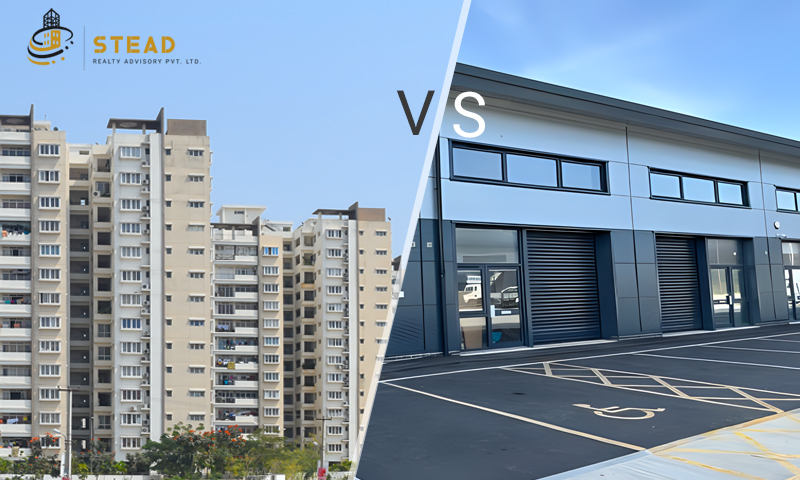Commercial or Residential: Which one Offers a Superior Rental Yield?
The real estate industry is booming. Besides giving a sense of security and pride, buying a property is a great investment!
Be it commercial or residential, investing in properties enables an individual to generate passive income. From renting to leasing, the buyer or a fractional owner can earn regular income. At the same time, the value of capital appreciates over a period of time. It’s a win-win! Both commercial and residential provide a greater rental yield.
One of the primary considerations for real estate investors is whether to venture into the residential or commercial sector. Both types of properties offer distinct advantages and drawbacks, including differences in rental yields, which can significantly impact the profitability of an investment.
Understanding the key factors influencing these yields is essential in making informed investment decisions.
Understanding What is a Good Rental Yield
Rental yield is a key metric used to evaluate the profitability of a property investment. It measures the annual income generated from rent, expressed as a percentage of the property’s value. In essence, it helps investors gauge the potential return on their investment.
Residential Properties: The Appeal and Prospects
Residential properties, such as single-family homes, apartments, or condominiums, often attract investors due to their familiarity and perceived stability. They tend to be more accessible to a broader range of tenants, making them potentially easier to rent out. Additionally, residential properties generally experience less turnover, providing a more stable income stream.
In many cases, residential properties offer the advantage of shorter lease terms, typically a year or less. This provides an opportunity to adjust rental rates more frequently, aligning them with market changes and potentially maximising income. Furthermore, the emotional connection people have with their homes often results in tenants taking better care of the property, reducing maintenance costs for landlords.
The Allure of Commercial Properties
On the other hand, commercial properties, including office buildings, retail spaces, and warehouses, present a different set of opportunities. These properties often feature longer lease terms, which can provide greater stability in terms of income for investors. Moreover, the responsibility for maintenance and some operating costs might fall on the tenant, easing the landlord’s financial burden.
Commercial properties frequently attract businesses as tenants, many of which might have stronger financial capabilities than individual renters. This could lead to a more reliable rental income stream, with a lower risk of payment defaults.
The Evaluation Process: Which Yields Higher Returns?
Determining which type of property offers a superior rental yield involves analysing various factors:
- Rental Income: While commercial properties tend to have higher rental incomes due to the larger scale and typically longer lease terms, residential properties might have more consistent demand.
- Expenses: Commercial properties often come with higher initial investment and maintenance costs. However, residential properties might have ongoing maintenance and turnover costs due to more frequent tenant changes.
- Vacancy Rates: The vacancy risk differs significantly between the two. Residential properties may experience shorter vacancy periods, while commercial properties may face longer vacancies but with higher returns when leased.
- Market Dynamics: The local real estate market and economic conditions significantly influence rental yields in both commercial and residential sectors.
A Summary: Commercial v/s Residential
Commercial Properties
- Types of Properties: Shops, restaurants, warehouses, office spaces, etc.
- Type of Investors: High-Risk appetite investors
- Initial Cost: Comparatively higher than residential
- Operating Cost: Higher in comparison to the extensive amenities
- Lease Tenure: Longer than a year or two
- Rental Income: Higher than residential
Residential Properties
- Types of Properties: Apartments, villas, houses, mansions, etc.
- Type of Investors: Medium and Low-Risk Appetite
- Initial Cost: Comparatively lower than Commercials
- Operating Cost: Minimal infrastructure and common utilities
- Lease Tenure: Maximum for two years at a stretch
- Rental Income: Lower than commercials
It takes time to find tenants for commercial properties. For a person who can invest in a huge property at a supreme location, commercial properties can be a better source of rental income.
Conclusion: The Verdict on Commercial & Residential Rental Yields In India
The decision between commercial and residential properties ultimately depends on an investor’s risk tolerance, financial goals, and market dynamics. Each type of property investment offers its own unique advantages and challenges.
While commercial properties yield higher returns in some cases, they often require a more substantial initial investment and involve more complex management. Residential properties, on the other hand, might offer a more steady, albeit potentially lower, rental yield but with lower entry barriers and potentially simpler management.
In conclusion, neither commercial nor residential properties definitively offer a superior rental yield. The choice between the two depends on an investor’s specific circumstances and investment objectives.
Understanding the nuances and potential risks of commercial and residential real estate is vital for making informed investment decisions and maximising rental yield.
Ultimately, a diversified real estate portfolio might be the ideal approach, blending the advantages of both types of properties and mitigating potential downsides, thereby maximising overall rental yield and balancing risk.
In the realm of real estate investment, knowledge, research, and a thorough understanding of the market are pivotal in making informed and successful investment decisions. Invest wisely and strategically to harness the full potential of real estate as a means of generating passive income and securing your financial future.
Whether commercial or residential property, we can help you get the best rental yields in Mumbai. We have our own team of researchers and analysts who constantly study the market trends to provide you with a detailed-oriented study and offer you the best deals at a reasonable price.
Happy Buying!
FAQ
Q1: What factors influence rental yield in commercial properties?
Commercial rental yield depends on location, tenant quality, and lease terms, influencing potential returns.
Q2: Is residential rental yield more stable than commercial?
Stability varies, with residential properties often offering steadier income streams, but commercial properties may yield higher returns.
Q3: Which property type is better for long-term investment in terms of rental yield?
The choice depends on individual goals; residential suits steady income, while commercial may offer higher returns over the long term.
Q4: In summary, which property type is recommended for superior rental yield?
The choice between commercial and residential depends on individual risk tolerance, investment goals, and market conditions. Each has its merits, and a well-informed decision is crucial for maximizing rental yield.
Q5: Are there strategies to maximize rental yield irrespective of property type?
Implement effective property management, stay informed about market trends, and adapt investment strategies to optimize rental yield regardless of property type.







